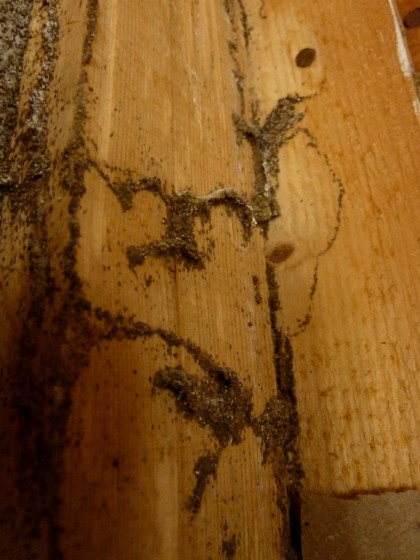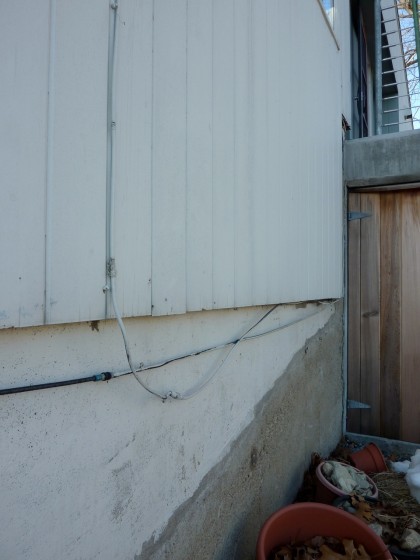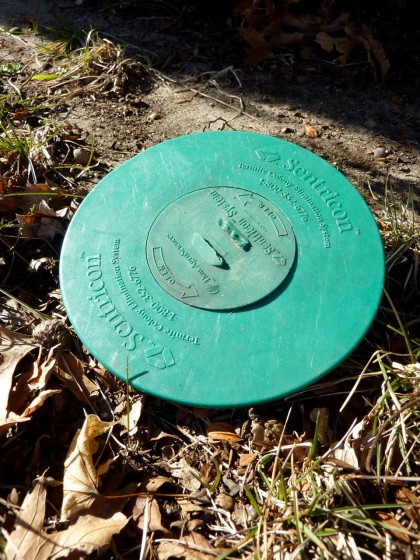Okay, I’ve put this off long enough. Time to address the termites. Last week, tearing off the drywall downstairs revealed this…
A sign that we’ve had some subterranean termite activity. Are they active now? Unclear. Here’s what we do know: Subterranean termites live, as the name implies, in the soil. They require moist soil to survive and build mud tubes to travel through the ground to their food sources. When exposed to the air, they die.
How did they get in? Through the soil that, until last spring, led them to a gap between the foundation and the wood cladding…
You can see where we regraded and flattened out the slope just below the upper patio — this is just on the other side of the wall from where we found signs of termites. No more termite tunnels here. In fact, with all of last year’s retaining wall building, rainwater collection tank hole digging and patio construction, we’ve completely disturbed the soil around three sides of the house (as well as the entire yard). Although this doesn’t mean we’re done with the pests forever, this definitely helps.
New England Pest Control stopped by to give their assessment. They recommend a chemical barrier, of course. Pumping chemicals 2′ into the ground all around the house is the standard approach. A typical termite treatment can require that well over 100 gallons of insecticide be injected into the soil — and additional annual treatments may be necessary.
From what I can ascertain (and I am no expert), pyrethroids are commonly used for this kind of treatment. Are they toxic? Duh. This is just a smattering pulled from this article on pyrethroids at beyondpesticide.org:
… linked to disruption of the endocrine system, which can adversely affect reproduction and sexual development, interfere with the immune system and increase chances of breast cancer. Pyrethroids contain human-made, or xenoestrogens, which can increase the amount of estrogen in the body…
… extremely toxic to aquatic organisms…
… moderately toxic to birds…
Both pyrethroids and pyrethrins are often formulated with oils or petroleum distillates and packaged in combination with synergists, such as piperonyl butoxide (PBO) and n-octyl bicycloheptene dicarboximide… PBO inhibits important liver enzymes responsible for breakdown of some toxins, including the active ingredients of pesticides. Symptoms of PBO poisoning include anorexia, vomiting, diarrhea, intestinal inflammation, pulmonary hemorrhage and perhaps mild central nervous system depression. Chronic toxicity studies have shown increased liver weights, even at the lowest doses…
And so on. Feel free to read it for yourself.
Now I’ve said from the beginning that David and I are struggling to be as environmentally friendly as we can in this remodel — and in life in general. The idea of pumping hundreds of gallons of toxic chemicals into the ground just goes against the grain. Although we want to be rid of termites forever, let’s be reasonable. Termites are a fact in New England. There has to be a non-toxic way to manage them, right?
The answer is yes. It looks like destroying any tubes that lead to the house is a good start. Pretty sure we’ve done that but we’ll need to do more than that. I’ll whip up another post next week on our non-toxic alternatives. Let me preface that post with this: Less than 20′ away, our neighbor opted for a termite baiting system over chemicals injected into the soil…
Those ring his entire house at about 7′ intervals. This is more along the lines of what we’re hoping for. More on that later!
Tags: alternative pest control, non-toxic termite control, termites


